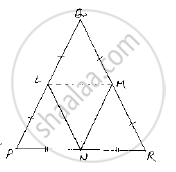Advertisements
Advertisements
प्रश्न
In a ΔPQR, if PQ = QR and L, M and N are the mid-points of the sides PQ, QR and RP
respectively. Prove that LN = MN.
उत्तर १
Given that in , ΔPQR, PQ= QR and ,L M and N are mid-points of PQ, QR and RP respectively
We have to prove LN = MN.
Join L and M, M and N, N and L
We have
PL =LQ,QM =MR and RN = NP
[ ∵L,M and N are mid-points of PQ, QR and RP respectively]
And also
PQ=QR⇒PL=LQ=QM=MR=`(PQ)/2=(QR)/2` ........(1) Using mid-point
theorem, we have
`MN ll PQ and MN=1/2PQ⇒ MN=PL=LQ` .........(2)
Similarly, we have
`LN ll QR and LN=1/2QR ⇒ LN=QM=MR` ...........(3)
From equation (1), (2) and (3), we have
PL=LQ=QM=MR=MN=LN
∴LN=MN

उत्तर २
Given that in , ΔPQR, PQ= QR and ,L M and N are mid-points of PQ, QR and RP respectively
We have to prove LN = MN.
Join L and M, M and N, N and L
We have
PL =LQ,QM =MR and RN = NP
[ ∵L,M and N are mid-points of PQ, QR and RP respectively]
And also
PQ=QR⇒PL=LQ=QM=MR=`(PQ)/2=(QR)/2` ........(1) Using mid-point
theorem, we have
`MN ll PQ and MN=1/2PQ⇒ MN=PL=LQ` .........(2)
Similarly, we have
`LN ll QR and LN=1/2QR ⇒ LN=QM=MR` ...........(3)
From equation (1), (2) and (3), we have
PL=LQ=QM=MR=MN=LN
∴LN=MN

